Evaluating Funding Models in Australian Public Hospitals & NEP Impact
VerifiedAdded on 2023/06/03
|7
|1393
|469
Report
AI Summary
This report identifies and describes the funding models used by public hospitals in Australia, referencing Eagar et al. (2013). It discusses best practice pricing, normative strategy, quality strategy, and paying for performance models. The report also evaluates the extent to which the National Efficient Price (NEP) may provide an incentive to improve the health status of a selected segment of the Australian population, particularly focusing on the indigenous population. The analysis considers how NEP incentives, such as those related to ICU adjustments and specialist psychiatric facilities, contribute to improved healthcare access and outcomes. It concludes that NEP, by providing incentives for quality and cost reduction, enhances the health services provided by Australian public hospitals.
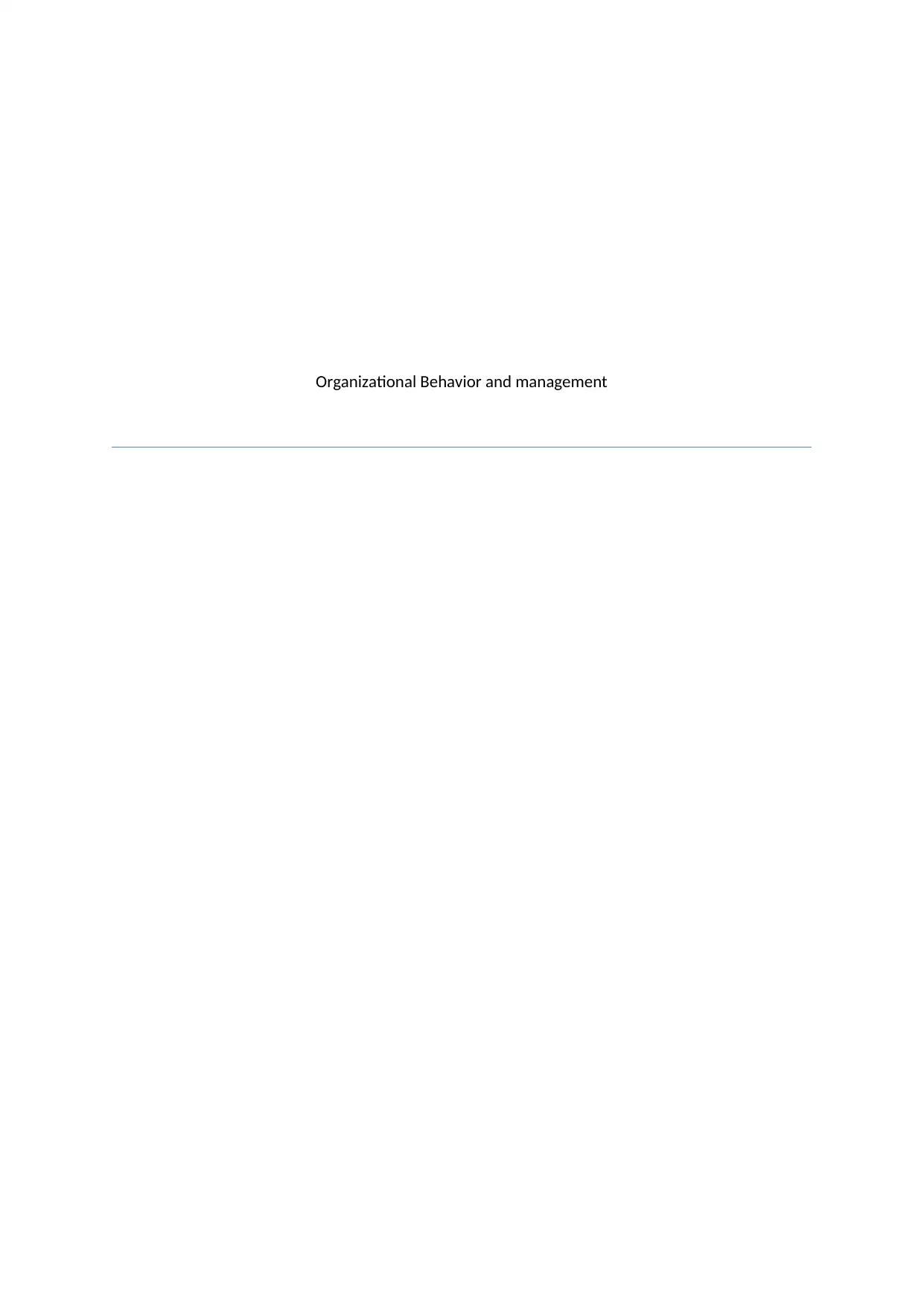
Organizational Behavior and management
Paraphrase This Document
Need a fresh take? Get an instant paraphrase of this document with our AI Paraphraser
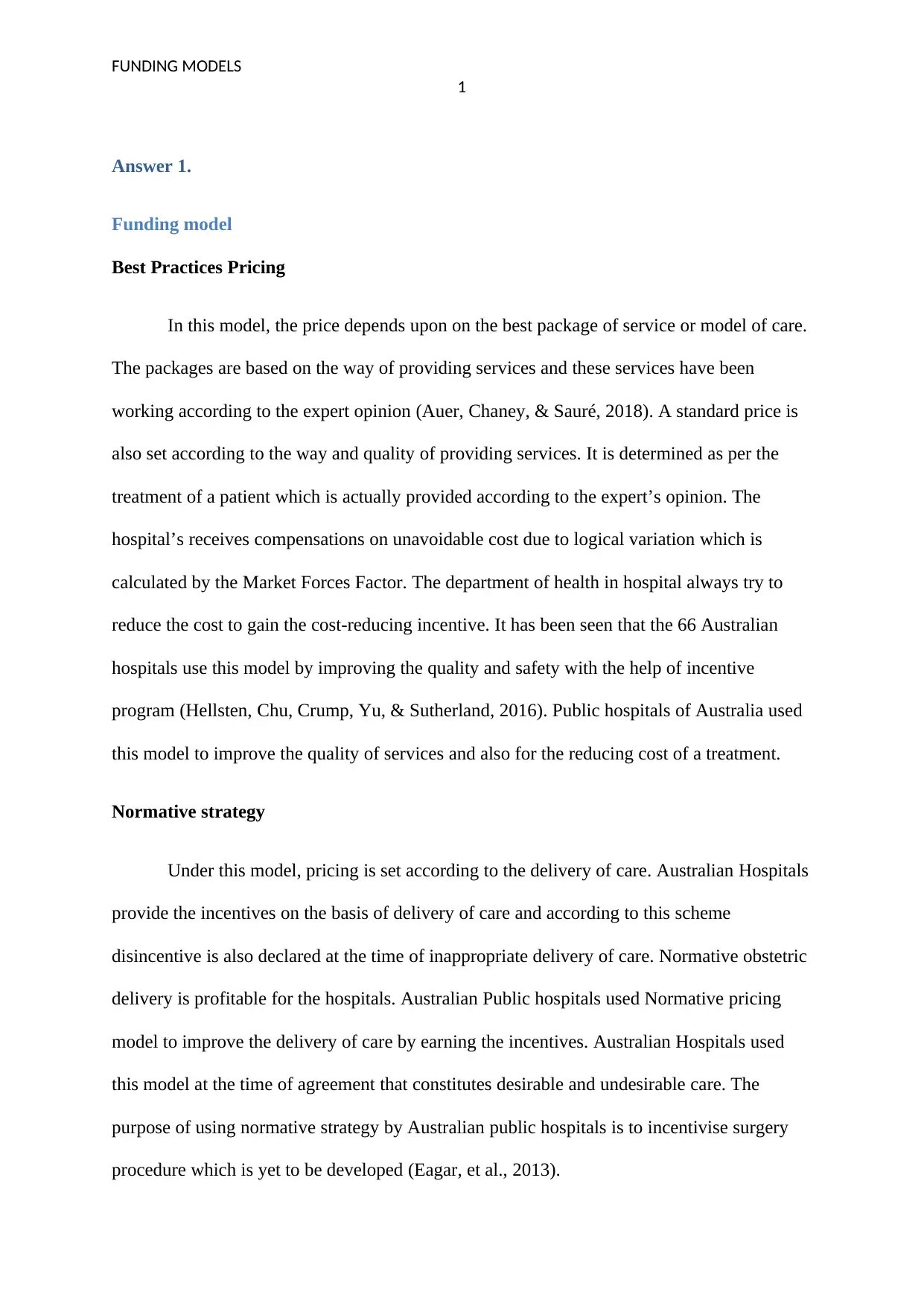
FUNDING MODELS
1
Answer 1.
Funding model
Best Practices Pricing
In this model, the price depends upon on the best package of service or model of care.
The packages are based on the way of providing services and these services have been
working according to the expert opinion (Auer, Chaney, & Sauré, 2018). A standard price is
also set according to the way and quality of providing services. It is determined as per the
treatment of a patient which is actually provided according to the expert’s opinion. The
hospital’s receives compensations on unavoidable cost due to logical variation which is
calculated by the Market Forces Factor. The department of health in hospital always try to
reduce the cost to gain the cost-reducing incentive. It has been seen that the 66 Australian
hospitals use this model by improving the quality and safety with the help of incentive
program (Hellsten, Chu, Crump, Yu, & Sutherland, 2016). Public hospitals of Australia used
this model to improve the quality of services and also for the reducing cost of a treatment.
Normative strategy
Under this model, pricing is set according to the delivery of care. Australian Hospitals
provide the incentives on the basis of delivery of care and according to this scheme
disincentive is also declared at the time of inappropriate delivery of care. Normative obstetric
delivery is profitable for the hospitals. Australian Public hospitals used Normative pricing
model to improve the delivery of care by earning the incentives. Australian Hospitals used
this model at the time of agreement that constitutes desirable and undesirable care. The
purpose of using normative strategy by Australian public hospitals is to incentivise surgery
procedure which is yet to be developed (Eagar, et al., 2013).
1
Answer 1.
Funding model
Best Practices Pricing
In this model, the price depends upon on the best package of service or model of care.
The packages are based on the way of providing services and these services have been
working according to the expert opinion (Auer, Chaney, & Sauré, 2018). A standard price is
also set according to the way and quality of providing services. It is determined as per the
treatment of a patient which is actually provided according to the expert’s opinion. The
hospital’s receives compensations on unavoidable cost due to logical variation which is
calculated by the Market Forces Factor. The department of health in hospital always try to
reduce the cost to gain the cost-reducing incentive. It has been seen that the 66 Australian
hospitals use this model by improving the quality and safety with the help of incentive
program (Hellsten, Chu, Crump, Yu, & Sutherland, 2016). Public hospitals of Australia used
this model to improve the quality of services and also for the reducing cost of a treatment.
Normative strategy
Under this model, pricing is set according to the delivery of care. Australian Hospitals
provide the incentives on the basis of delivery of care and according to this scheme
disincentive is also declared at the time of inappropriate delivery of care. Normative obstetric
delivery is profitable for the hospitals. Australian Public hospitals used Normative pricing
model to improve the delivery of care by earning the incentives. Australian Hospitals used
this model at the time of agreement that constitutes desirable and undesirable care. The
purpose of using normative strategy by Australian public hospitals is to incentivise surgery
procedure which is yet to be developed (Eagar, et al., 2013).
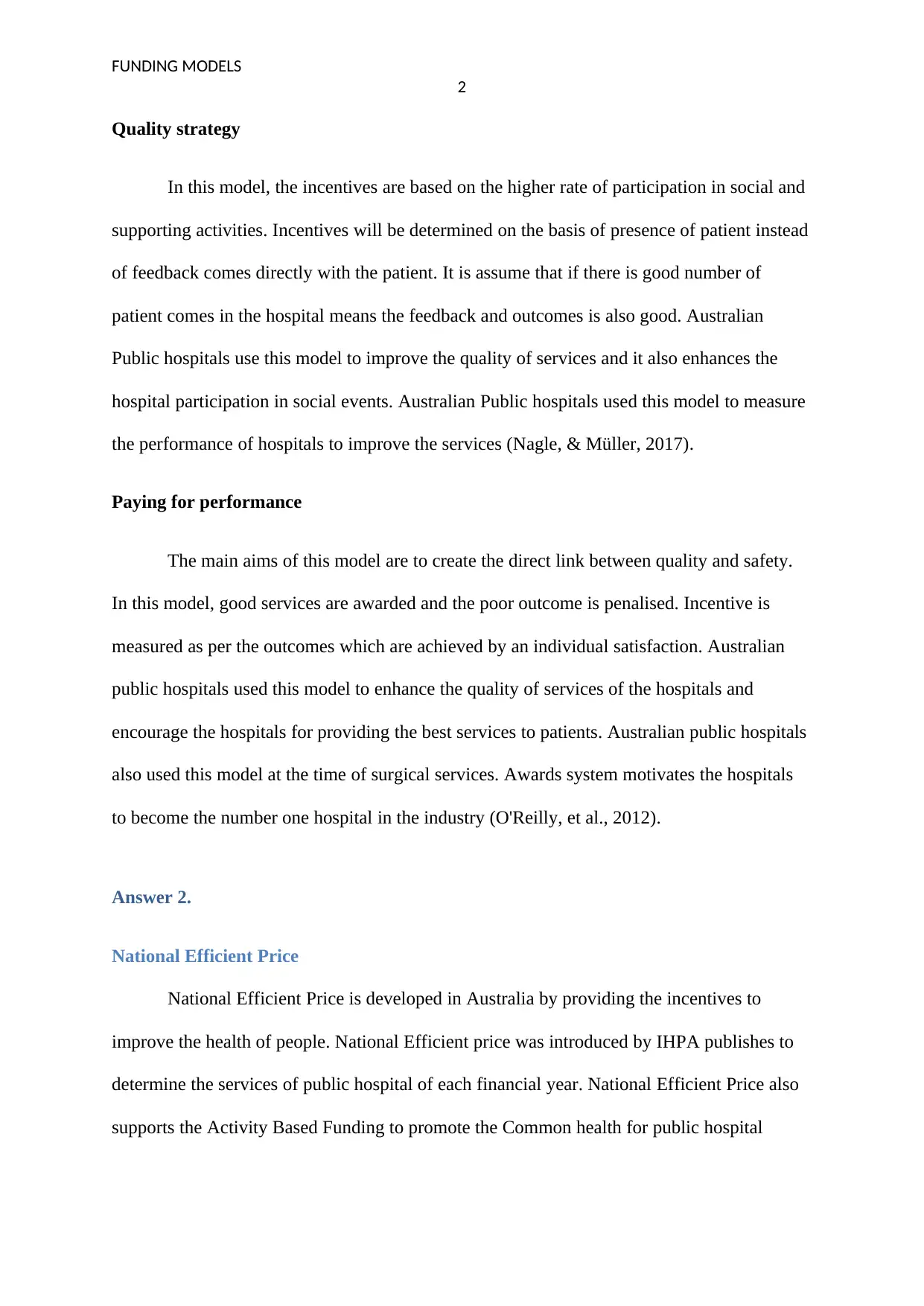
FUNDING MODELS
2
Quality strategy
In this model, the incentives are based on the higher rate of participation in social and
supporting activities. Incentives will be determined on the basis of presence of patient instead
of feedback comes directly with the patient. It is assume that if there is good number of
patient comes in the hospital means the feedback and outcomes is also good. Australian
Public hospitals use this model to improve the quality of services and it also enhances the
hospital participation in social events. Australian Public hospitals used this model to measure
the performance of hospitals to improve the services (Nagle, & Müller, 2017).
Paying for performance
The main aims of this model are to create the direct link between quality and safety.
In this model, good services are awarded and the poor outcome is penalised. Incentive is
measured as per the outcomes which are achieved by an individual satisfaction. Australian
public hospitals used this model to enhance the quality of services of the hospitals and
encourage the hospitals for providing the best services to patients. Australian public hospitals
also used this model at the time of surgical services. Awards system motivates the hospitals
to become the number one hospital in the industry (O'Reilly, et al., 2012).
Answer 2.
National Efficient Price
National Efficient Price is developed in Australia by providing the incentives to
improve the health of people. National Efficient price was introduced by IHPA publishes to
determine the services of public hospital of each financial year. National Efficient Price also
supports the Activity Based Funding to promote the Common health for public hospital
2
Quality strategy
In this model, the incentives are based on the higher rate of participation in social and
supporting activities. Incentives will be determined on the basis of presence of patient instead
of feedback comes directly with the patient. It is assume that if there is good number of
patient comes in the hospital means the feedback and outcomes is also good. Australian
Public hospitals use this model to improve the quality of services and it also enhances the
hospital participation in social events. Australian Public hospitals used this model to measure
the performance of hospitals to improve the services (Nagle, & Müller, 2017).
Paying for performance
The main aims of this model are to create the direct link between quality and safety.
In this model, good services are awarded and the poor outcome is penalised. Incentive is
measured as per the outcomes which are achieved by an individual satisfaction. Australian
public hospitals used this model to enhance the quality of services of the hospitals and
encourage the hospitals for providing the best services to patients. Australian public hospitals
also used this model at the time of surgical services. Awards system motivates the hospitals
to become the number one hospital in the industry (O'Reilly, et al., 2012).
Answer 2.
National Efficient Price
National Efficient Price is developed in Australia by providing the incentives to
improve the health of people. National Efficient price was introduced by IHPA publishes to
determine the services of public hospital of each financial year. National Efficient Price also
supports the Activity Based Funding to promote the Common health for public hospital
⊘ This is a preview!⊘
Do you want full access?
Subscribe today to unlock all pages.

Trusted by 1+ million students worldwide
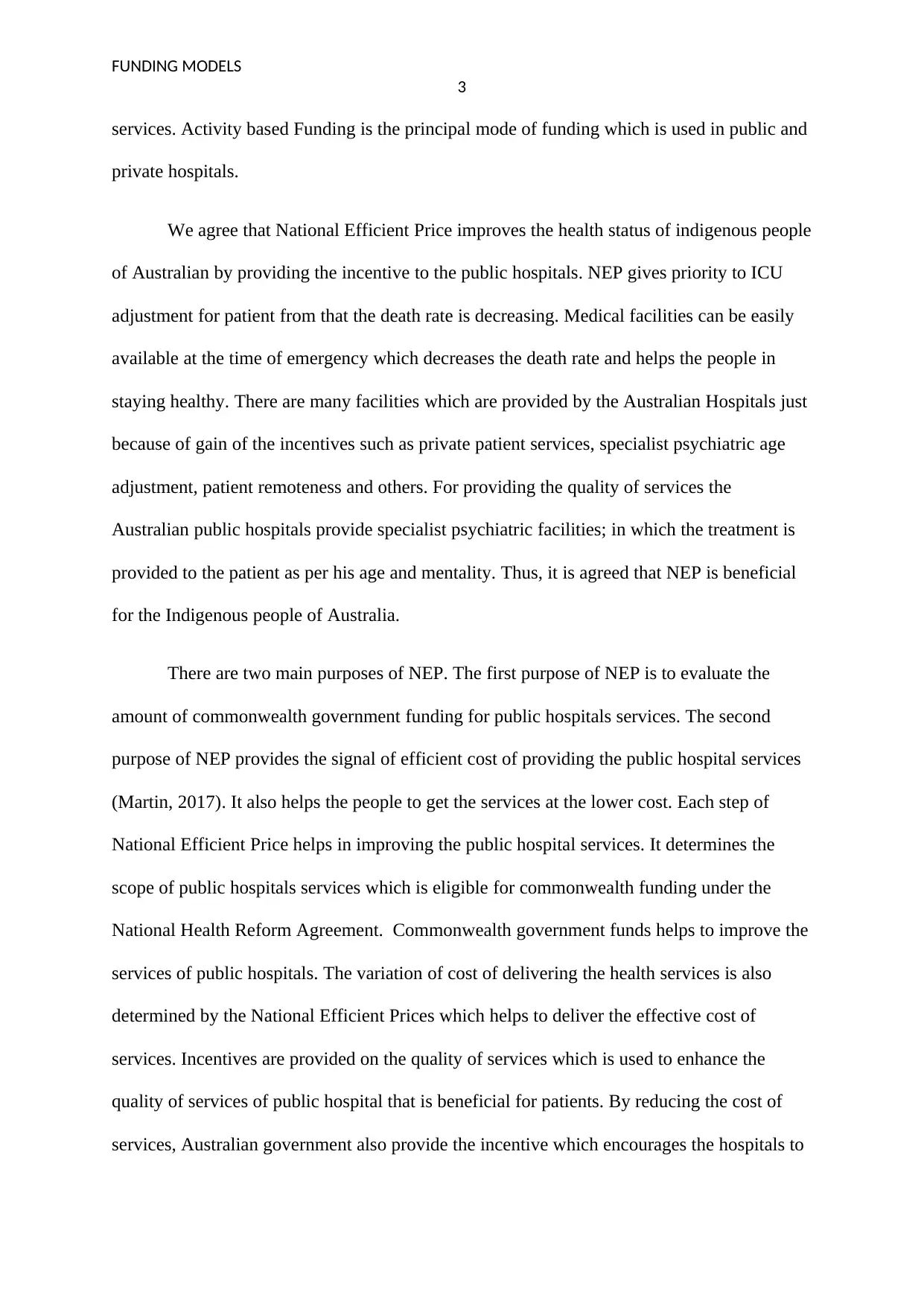
FUNDING MODELS
3
services. Activity based Funding is the principal mode of funding which is used in public and
private hospitals.
We agree that National Efficient Price improves the health status of indigenous people
of Australian by providing the incentive to the public hospitals. NEP gives priority to ICU
adjustment for patient from that the death rate is decreasing. Medical facilities can be easily
available at the time of emergency which decreases the death rate and helps the people in
staying healthy. There are many facilities which are provided by the Australian Hospitals just
because of gain of the incentives such as private patient services, specialist psychiatric age
adjustment, patient remoteness and others. For providing the quality of services the
Australian public hospitals provide specialist psychiatric facilities; in which the treatment is
provided to the patient as per his age and mentality. Thus, it is agreed that NEP is beneficial
for the Indigenous people of Australia.
There are two main purposes of NEP. The first purpose of NEP is to evaluate the
amount of commonwealth government funding for public hospitals services. The second
purpose of NEP provides the signal of efficient cost of providing the public hospital services
(Martin, 2017). It also helps the people to get the services at the lower cost. Each step of
National Efficient Price helps in improving the public hospital services. It determines the
scope of public hospitals services which is eligible for commonwealth funding under the
National Health Reform Agreement. Commonwealth government funds helps to improve the
services of public hospitals. The variation of cost of delivering the health services is also
determined by the National Efficient Prices which helps to deliver the effective cost of
services. Incentives are provided on the quality of services which is used to enhance the
quality of services of public hospital that is beneficial for patients. By reducing the cost of
services, Australian government also provide the incentive which encourages the hospitals to
3
services. Activity based Funding is the principal mode of funding which is used in public and
private hospitals.
We agree that National Efficient Price improves the health status of indigenous people
of Australian by providing the incentive to the public hospitals. NEP gives priority to ICU
adjustment for patient from that the death rate is decreasing. Medical facilities can be easily
available at the time of emergency which decreases the death rate and helps the people in
staying healthy. There are many facilities which are provided by the Australian Hospitals just
because of gain of the incentives such as private patient services, specialist psychiatric age
adjustment, patient remoteness and others. For providing the quality of services the
Australian public hospitals provide specialist psychiatric facilities; in which the treatment is
provided to the patient as per his age and mentality. Thus, it is agreed that NEP is beneficial
for the Indigenous people of Australia.
There are two main purposes of NEP. The first purpose of NEP is to evaluate the
amount of commonwealth government funding for public hospitals services. The second
purpose of NEP provides the signal of efficient cost of providing the public hospital services
(Martin, 2017). It also helps the people to get the services at the lower cost. Each step of
National Efficient Price helps in improving the public hospital services. It determines the
scope of public hospitals services which is eligible for commonwealth funding under the
National Health Reform Agreement. Commonwealth government funds helps to improve the
services of public hospitals. The variation of cost of delivering the health services is also
determined by the National Efficient Prices which helps to deliver the effective cost of
services. Incentives are provided on the quality of services which is used to enhance the
quality of services of public hospital that is beneficial for patients. By reducing the cost of
services, Australian government also provide the incentive which encourages the hospitals to
Paraphrase This Document
Need a fresh take? Get an instant paraphrase of this document with our AI Paraphraser
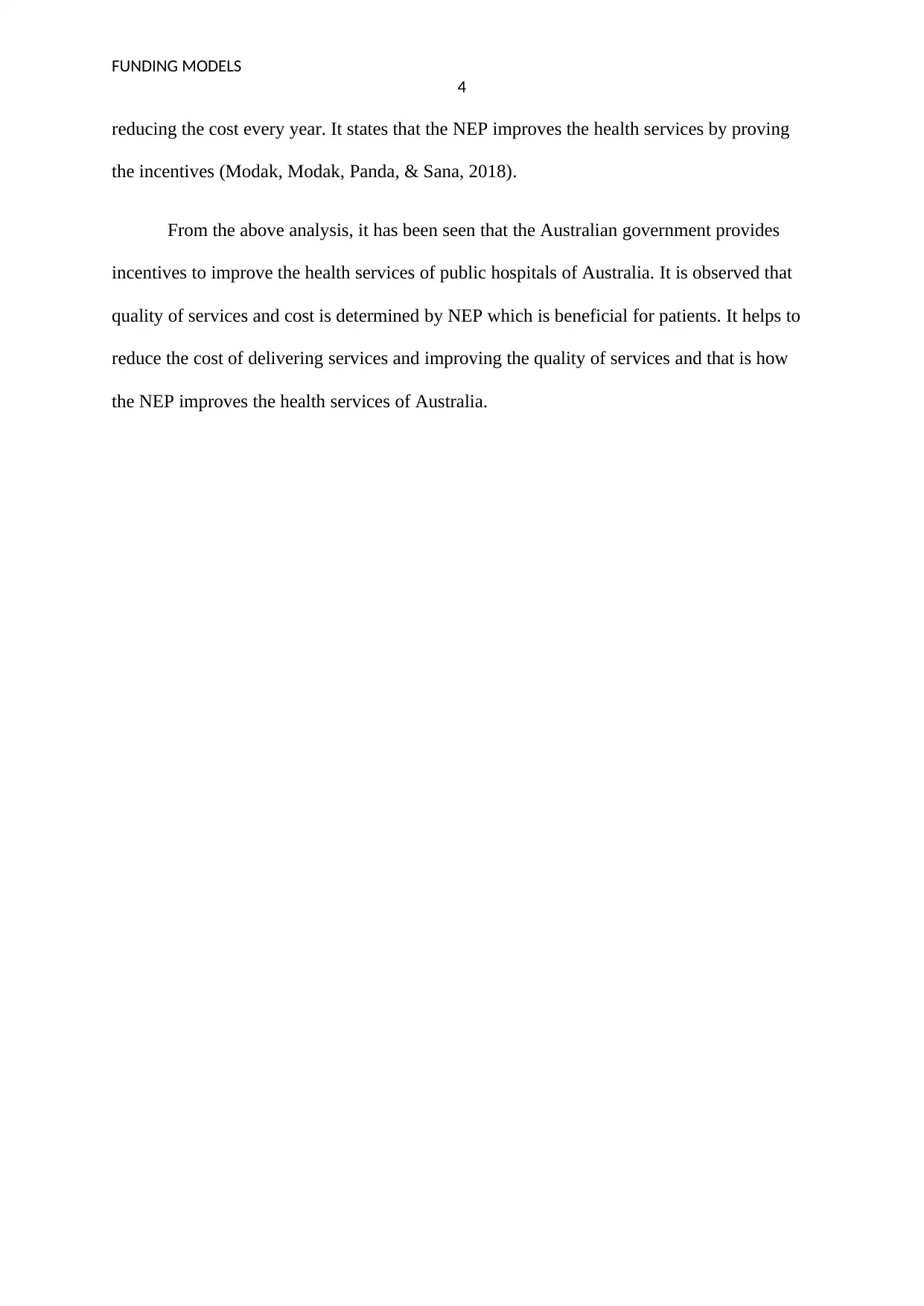
FUNDING MODELS
4
reducing the cost every year. It states that the NEP improves the health services by proving
the incentives (Modak, Modak, Panda, & Sana, 2018).
From the above analysis, it has been seen that the Australian government provides
incentives to improve the health services of public hospitals of Australia. It is observed that
quality of services and cost is determined by NEP which is beneficial for patients. It helps to
reduce the cost of delivering services and improving the quality of services and that is how
the NEP improves the health services of Australia.
4
reducing the cost every year. It states that the NEP improves the health services by proving
the incentives (Modak, Modak, Panda, & Sana, 2018).
From the above analysis, it has been seen that the Australian government provides
incentives to improve the health services of public hospitals of Australia. It is observed that
quality of services and cost is determined by NEP which is beneficial for patients. It helps to
reduce the cost of delivering services and improving the quality of services and that is how
the NEP improves the health services of Australia.
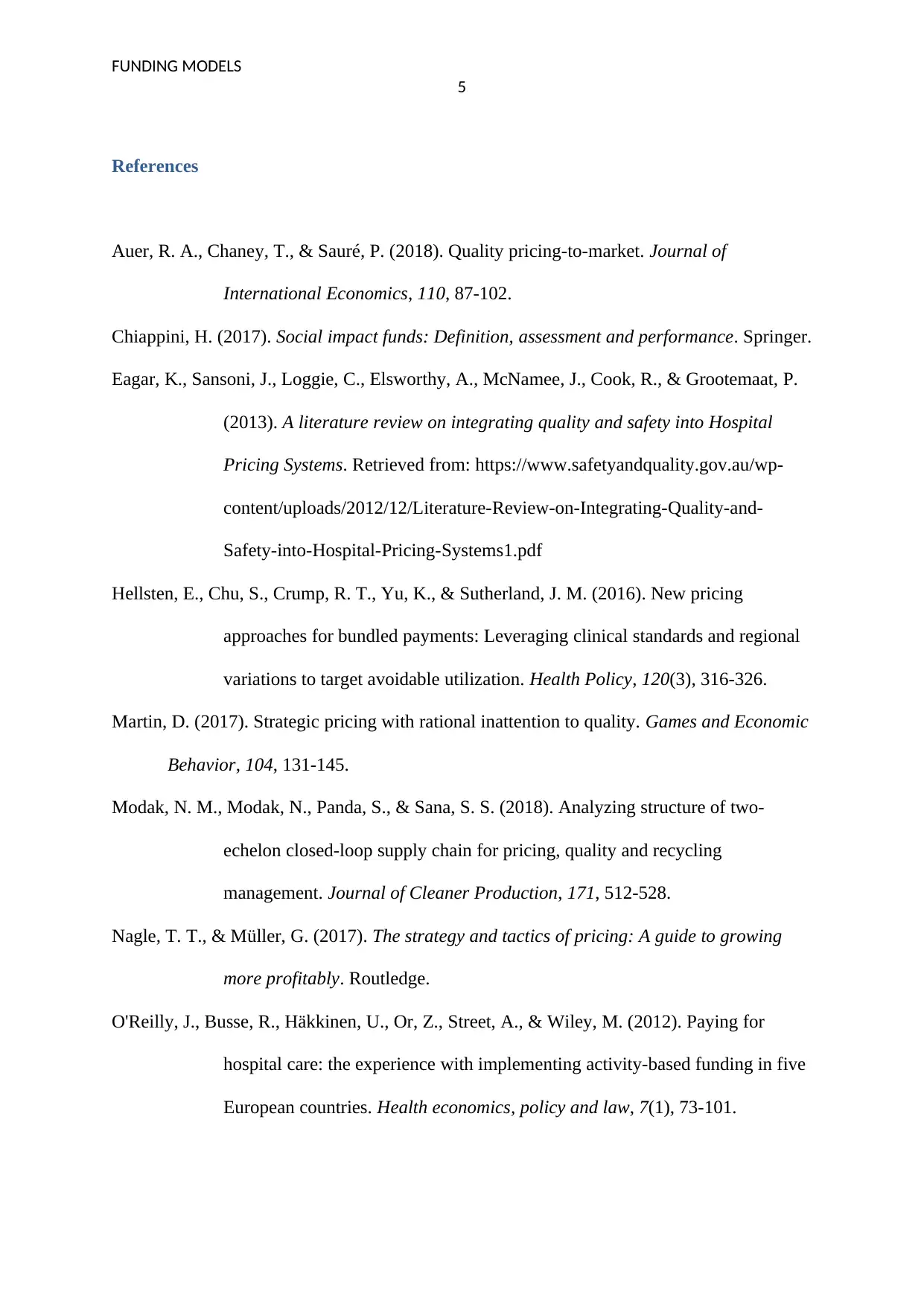
FUNDING MODELS
5
References
Auer, R. A., Chaney, T., & Sauré, P. (2018). Quality pricing-to-market. Journal of
International Economics, 110, 87-102.
Chiappini, H. (2017). Social impact funds: Definition, assessment and performance. Springer.
Eagar, K., Sansoni, J., Loggie, C., Elsworthy, A., McNamee, J., Cook, R., & Grootemaat, P.
(2013). A literature review on integrating quality and safety into Hospital
Pricing Systems. Retrieved from: https://www.safetyandquality.gov.au/wp-
content/uploads/2012/12/Literature-Review-on-Integrating-Quality-and-
Safety-into-Hospital-Pricing-Systems1.pdf
Hellsten, E., Chu, S., Crump, R. T., Yu, K., & Sutherland, J. M. (2016). New pricing
approaches for bundled payments: Leveraging clinical standards and regional
variations to target avoidable utilization. Health Policy, 120(3), 316-326.
Martin, D. (2017). Strategic pricing with rational inattention to quality. Games and Economic
Behavior, 104, 131-145.
Modak, N. M., Modak, N., Panda, S., & Sana, S. S. (2018). Analyzing structure of two-
echelon closed-loop supply chain for pricing, quality and recycling
management. Journal of Cleaner Production, 171, 512-528.
Nagle, T. T., & Müller, G. (2017). The strategy and tactics of pricing: A guide to growing
more profitably. Routledge.
O'Reilly, J., Busse, R., Häkkinen, U., Or, Z., Street, A., & Wiley, M. (2012). Paying for
hospital care: the experience with implementing activity-based funding in five
European countries. Health economics, policy and law, 7(1), 73-101.
5
References
Auer, R. A., Chaney, T., & Sauré, P. (2018). Quality pricing-to-market. Journal of
International Economics, 110, 87-102.
Chiappini, H. (2017). Social impact funds: Definition, assessment and performance. Springer.
Eagar, K., Sansoni, J., Loggie, C., Elsworthy, A., McNamee, J., Cook, R., & Grootemaat, P.
(2013). A literature review on integrating quality and safety into Hospital
Pricing Systems. Retrieved from: https://www.safetyandquality.gov.au/wp-
content/uploads/2012/12/Literature-Review-on-Integrating-Quality-and-
Safety-into-Hospital-Pricing-Systems1.pdf
Hellsten, E., Chu, S., Crump, R. T., Yu, K., & Sutherland, J. M. (2016). New pricing
approaches for bundled payments: Leveraging clinical standards and regional
variations to target avoidable utilization. Health Policy, 120(3), 316-326.
Martin, D. (2017). Strategic pricing with rational inattention to quality. Games and Economic
Behavior, 104, 131-145.
Modak, N. M., Modak, N., Panda, S., & Sana, S. S. (2018). Analyzing structure of two-
echelon closed-loop supply chain for pricing, quality and recycling
management. Journal of Cleaner Production, 171, 512-528.
Nagle, T. T., & Müller, G. (2017). The strategy and tactics of pricing: A guide to growing
more profitably. Routledge.
O'Reilly, J., Busse, R., Häkkinen, U., Or, Z., Street, A., & Wiley, M. (2012). Paying for
hospital care: the experience with implementing activity-based funding in five
European countries. Health economics, policy and law, 7(1), 73-101.
⊘ This is a preview!⊘
Do you want full access?
Subscribe today to unlock all pages.

Trusted by 1+ million students worldwide

FUNDING MODELS
6
6
1 out of 7
Related Documents
Your All-in-One AI-Powered Toolkit for Academic Success.
+13062052269
info@desklib.com
Available 24*7 on WhatsApp / Email
![[object Object]](/_next/static/media/star-bottom.7253800d.svg)
Unlock your academic potential
Copyright © 2020–2025 A2Z Services. All Rights Reserved. Developed and managed by ZUCOL.




